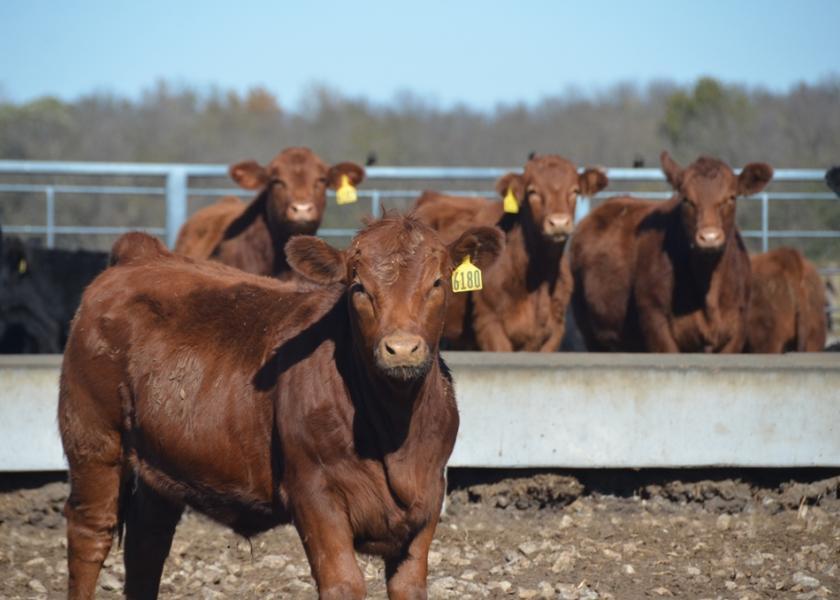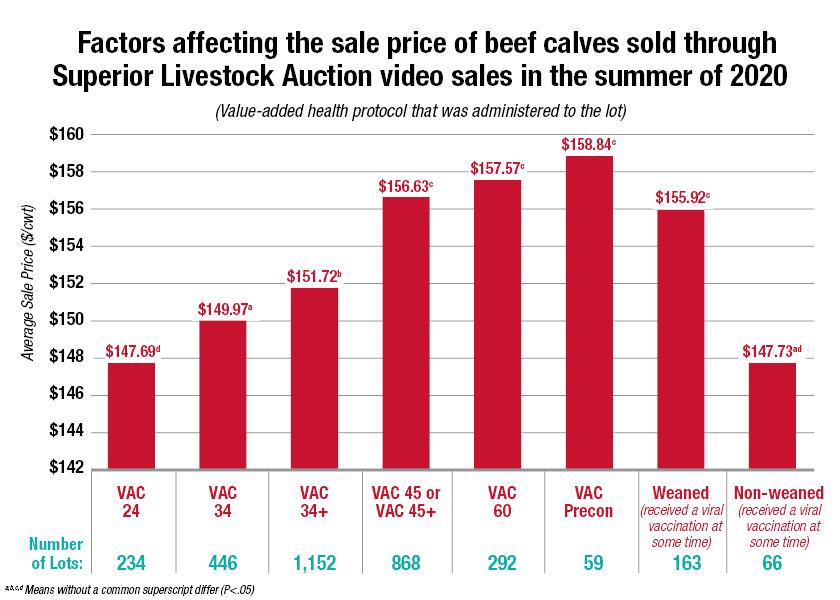Value-Added Premiums $50 Per Head, Data Show

Weaned calves are worth an average of about $50 per head more than their unweaned herd mates. That’s according to new data compiled from 393,600 calves sold through Superior Livestock Auction’s summer 2020 video sales.
The data analysis on vaccinated and weaned calves sold by Superior Livestock Auction (SLA) is an ongoing research project under the direction of Ken Odde, professor and former head of the Department of Animal Sciences at Kansas State University. To date, the project has collected data on over 25 million head of cattle.
Specifically, the analysis evaluated the sale price of calves from seven separate value-added health programs identified by SLA. Since the program analysis began more than a quarter-century ago, Odde said producers have responded to market signals by offering more weaned and vaccinated calves at sale time.
“Previous analyses compared prices to calves without any vaccinations or weaning,” Odde said. “Now, we hardly see any of those calves in the sales, so our base for comparing prices is now VAC 24 (calves vaccinated at branding and sold off the cow).”
VAC 24 calves sold during the summer of 2020 received an average sale price of $147.69 per cwt., or $8.94 per cwt. less than VAC 45 calves, and $9.88 per cwt. less than VAC 60 calves. The average weight of the calves in the analysis was 580 pounds, which delivered a $51.85 per head premium for the VAC 45 calves and a $57.30 per head premium for the VAC 60 calves.

Odde said the most popular programs are VAC 34 and VAC 34+. The VAC 34 program requires calves to be vaccinated 2 to 4 weeks prior to shipping while still nursing their dams. The VAC 34+ program require calves to be vaccinated twice while still nursing, once at branding and once 2 to 4 weeks prior to shipping. Together, the VAC 34 and VAC 34+ programs totaled 1,598 lots in the SLA sales.
VAC 34 calves sold for an average of $149.97 per cwt., or $2.28 per cwt. more ($13.22/head) than the VAC 24 base. The VAC 34+ calves sold for $151.72 per cwt., or $4.03 per cwt. more ($23.37/head) than the VAC 24 base.
The next most popular programs were VAC 45 and VAC 45+, which totaled 868 lots in the SLA sales.
The seven weaning and vaccination programs in the analysis are as follows:
Description of value-added health protocols in Superior Livestock Auction summer 2020 sales:
VAC 24
The VAC 24 health protocol was designed for beef calves that were nursing their dams and vaccinated at 2 to 4 months of age (branding).
Vaccination requirements:
- 1 dose of a 7, 8, or 9-way clostridial/blackleg vaccine.
- 1 dose of a viral 5-way (IBR, PI3, BRSV, and BVD Type 1 and 2) vaccine. The IBR and PI3 antigens must be chemically altered modified live or modified live with veterinarian’s approval. The BVD and BRSV antigens can be modified live or killed.
- 1 dose of a Mannheimia haemolytica and/or Pasteurella multocida vaccine.
- Internal and external parasite control was recommended.
VAC 34
Beef calves in the VAC 34 health protocol were vaccinated 2 to 4 weeks prior to shipping while still nursing their dams.
Vaccination requirements:
- 2 doses of a 7, 8, or 9-way clostridial/blackleg vaccine, the first dose at branding and the second dose 2 to 4 weeks prior to shipping.
- 1 dose of a viral 5-way (IBR, PI3, BRSV, and BVD Type 1 and 2) vaccine 2 to 4 weeks prior to shipping. The IBR and PI3 antigens must be chemically altered modified live or modified live with veterinarian’s approval. The BVD and BRSV antigens can be modified live or killed.
- 1 dose of a Mannheimia haemolytica and/or Pasteurella multocida vaccine 2 to 4 weeks prior to shipping.
- Internal and external parasite control was recommended.
VAC 34+
Beef calves that qualified for the VAC 34+ health protocol were vaccinated twice while still nursing their dams: once at branding and again 2 to 4 weeks prior to shipping.
Vaccination requirements:
- 2 doses of a 7, 8, or 9-way clostridial/blackleg vaccine, the first dose at branding and the second dose 2 to 4 weeks prior to shipping.
- 2 doses of a viral 5-way (IBR, PI3, BRSV, and BVD Type 1 and 2) vaccine, the first dose at branding and the second dose 2 to 4 weeks prior to shipping. The IBR and PI3 antigens must be chemically altered modified live or modified live with veterinarian’s approval. The BVD and BRSV antigens can be modified live or killed.
- 1 dose of a Mannheimia haemolytica and/or Pasteurella multocida vaccine 2 to 4 weeks prior to shipping.
- Internal and external parasite control was recommended.
VAC 45
The VAC 45 health protocol was designed for home-raised beef calves that were weaned a minimum of 45 days prior to delivery. These calves were vaccinated twice: the first vaccination was given at branding or 2 to 4 weeks prior to weaning with a booster dose at weaning, or the first vaccination was given at weaning with the second vaccination given according to vaccine label instructions.
Vaccination requirements:
- 2 doses of a 7, 8, or 9-way clostridial/blackleg vaccine.
- 2 doses of a viral 5-way (IBR, PI3, BRSV, and BVD Type 1 and 2) vaccine, the first dose at branding or 2 to 4 weeks prior to weaning and the booster dose at weaning, or vaccinated at weaning with the booster dose given according to label instructions. The IBR and PI3 antigens must be chemically altered modified live or modified live with veterinarian’s approval when given prior to weaning. The BVD and BRSV antigens can be modified live or killed.
- 1 dose of a Mannheimia haemolytica and/or Pasteurella multocida vaccine 2 to 4 weeks prior to or at weaning.
- Internal and external parasite control was recommended.
VAC 45+
The VAC 45+ health protocol was designed for home-raised beef calves that were weaned a minimum of 45 days prior to delivery. These calves were vaccinated three times: at branding, 2 to 4 weeks prior to weaning, and boostered at weaning, or at branding, at weaning, and boostered according to label instructions.
Vaccination requirements:
- 2 doses of a 7, 8, or 9-way clostridial/blackleg vaccine at branding, 2 to 4 weeks prior to or at weaning, and then boostered according to label instructions.
- 3 doses of a modified live viral 5-way (IBR, PI3, BRSV, and BVD Type 1 and 2) vaccine at branding, 2 to 4 weeks prior to weaning, and the booster dose at weaning, or at branding, at weaning, and then boostered according to label instructions.
- 2 doses of a Mannheimia haemolytica and/or Pasteurella multocida vaccine at branding, 2 to 4 weeks prior to or at weaning and boostered according to label instructions.
- Internal and external parasite control was required.
VAC 60
The VAC 60 health protocol was designed for home-raised beef calves that were weaned a minimum of 60 days prior to delivery. These calves were vaccinated twice: the first vaccination was given at branding or 2 to 4 weeks prior to weaning with a booster dose at weaning, or the first vaccination was given at weaning with the second vaccination given according to vaccine label instructions.
Vaccination requirements:
- 2 doses of a 7, 8, or 9-way clostridial/blackleg vaccine.
- 2 doses of a viral 5-way (IBR, PI3, BRSV, and BVD Type 1 and 2) vaccine, the first dose at branding or 2 to 4 weeks prior to weaning and the booster dose at weaning, or vaccinated at weaning with the booster dose given according to label instructions. The IBR and PI3 antigens must be chemically altered modified live or modified live with veterinarian’s approval when given prior to weaning. The BVD and BRSV antigens can be modified live or killed.
- 1 dose of a Mannheimia haemolytica and/or Pasteurella multocida vaccine 2 to 4 weeks prior to or at weaning.
- Internal and external parasite control was recommended.
VAC Precon
Beef calves in the VAC Precon health protocol were purchased from various sources and weaned a minimum of 60 days prior to delivery. These calves were vaccinated twice: at arrival and boostered according to label instructions with the booster vaccinations given at least 14 days prior to delivery.
Vaccination requirements:
- 2 doses of a 7, 8, or 9-way clostridial/blackleg vaccine, the first dose at arrival and then boostered according to label instructions.
- 2 doses of a modified live viral 5-way (IBR, PI3, BRSV, and BVD Type 1 and 2) vaccine, the first dose at arrival and the booster dose according to label instructions.
- 1 dose of a Mannheimia haemolytica and/or Pasteurella multocida vaccine at arrival.
- Internal and external parasite control was recommended.
_______________________________________________________________________________
A list of vaccines that qualify for the Superior Value-Added Calf health program can be found at the following Internet address: www.superiorlivestock.com/images/forms/qualifiedvaccines.pdf.







